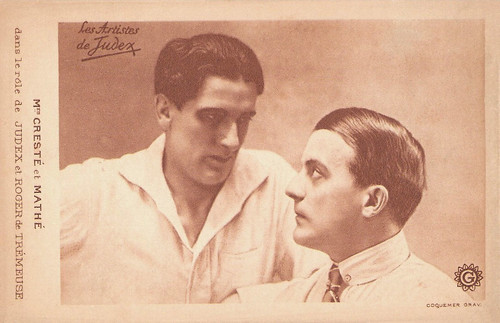
French postcard by Coquemer Gravures, Paris. Photo: Gaumont. Still for La nouvelle mission de Judex (Louis Feuillade, 1917-1918).
French postcard in the series Les Vedettes de l'Ecran by Editions Filma, no. 112.
Louis Feuillade
René Cresté was born in Paris, France, in 1881. He began his acting career on the stages of Paris as a jeune premier in plays such as Claudine à Paris (Claudine in Paris) by and with Colette, Ruy Blas by Victor Hugo, and Adrienne Lecouvreur by Eugene Scribe. In 1913, Alphonse Séché engaged him for his Nouveau Théâtre d’Art to play leading roles in several plays.
Cresté signed a contract with the Gaumont Film Company in 1908. Little is known of these first film appearances as they are considered lost. For Pathé he appeared in La chatte métamorphosée en femme/The cat transformed in a woman (Michel Carré, 1910) with Carlos Avril.
In 1912 he began appearing in a series of mystery shorts directed by Léonce Perret for Gaumont. These films included La bonne hôtesse/The good hostess (Léonce Perret, 1912) with Suzanne Grandais, Le mariage de Suzie/Suzie’s Wedding (Léonce Perret, 1912) with Suzanne Grandais, and Par l’amour/By Love (Léonce Perret, 1913) with Jean Aymé.
At the onset of the First World War, Cresté enlisted in the French army and actively participated in the fighting. Injured and demobilized, he resumed his acting career at Gaumont studios by the end of 1915 and appeared in Son or/His Gold (Louis Feuillade, 1915) with Yvette Andréyor, Dernier amour/Last Love (Léonce Perret, 1916) with Valentine Petit, and Le roi de la montagne/The King of the Mountain (Léonce Perret, 1916) with Fabienne Fabrèges.
In 1917 he played in several films for Louis Feuillade, including Le passé de Monique/Monique (Louis Feuillade, 1917) with Edouard Mathé, Mon Oncle/My Uncle (Louis Feuillade, 1917) with Musidora, and Les petites marionnettes/The small puppets (Louis Feuillade, 1917) again opposite Edouard Mathé.
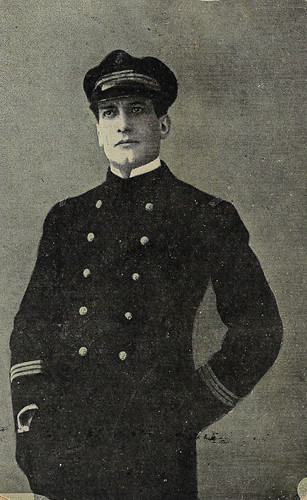
Spanish collector's card by Chocolate Pi, Barcelona, no. 1. Photo: Gaumont. René Cresté inLa déserteuse (Louis Feuillade, 1917). The Spanish release title was Tortura de madre.
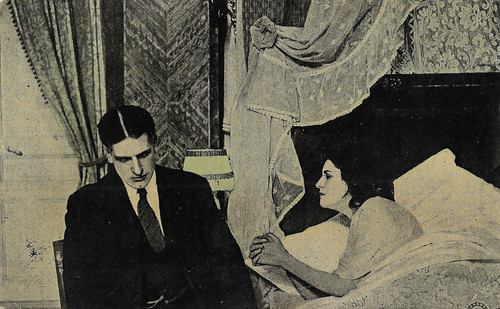
Spanish collectors card by Chocolate Pi, Barcelona, no. 6 (of six cards). Photo: Gaumont. Yvette Andreyor and René Cresté in La déserteuse/Déserteuse! (Louis Feuillade, 1917). The Spanish release title was Tortura de madre.

Spanish collectors card by Chocolate Pi, Barcelona, card 44 of 54. Photo: Gaumont. Judex (René Cresté) overhears a phone call by the evil Baronne d'Apremont (Juana Borguèse) in La Nouvelle mission de Judex/The New Mission of Judex (Louis Feuillade, 1917-1918).
Le Panthéon du cinéma
René Cresté was then cast for his greatest role – Judex, a positive hero who steals to help the poor. The character's arch-nemesis is the callous banker Favraux, who had carelessly driven thousands of people into bankruptcy. In 1916, Feuillade and writer Arthur Bernède had begun to develop a surrealistic character called 'Jacques de Tremeuse' (aka Judex) - a mysterious avenger who sports a signature long dark cloak, a wide-brimmed black hat, and a fatalistic air.
Judex (which means Justice) appears and disappears like a ghost, and would appear to have mild hypnotic powers. He is a master of disguise and an excellent fighter. He commands the loyalty of an organization composed of circus folks and redeemed Apaches. Finally, he flies a plane and has a secret lair, where he interrogates his prisoners through a ‘television’ screen - everything Judex writes on the screen on his desk appears on a similar screen on the wall of his victim's cell.
The serial began production in 1917 and was released the same year in its first instalment to critical and public praise. Jefferey M. Anderson at Combustible Celluloid calls Judex an ‘unalloyed masterwork’: “establishing Feuillade as one of history's greatest directors. He had an uncanny knack for finding shocking beauty in simple images, such as a gate or a wall or an antique car driving down the road”.
The character of Judex is widely recognized as one of cinema's first superheroes. René Cresté, who was already popular among female audiences, has now become an immensely popular film star. Judex also starred Musidora as villainess Diana Monti, Édouard Mathé, Gaston Michel, the young René Poyen, and Yvette Andréyor.
Simultaneously with the release of the serial, a novelisation, signed by both Feuillade and Bernède, was released, first as a serial in Le Petit Parisien, then in a collected edition by Tallandier. The following year a sequel was made, La nouvelle mission de Judex/The New Mission of Judex (Louis Feuillade, 1917), which landed Cresté definitively in ‘le Panthéon du cinéma’, as Philippe Pelletier writes so beautifully at Ciné Artistes.
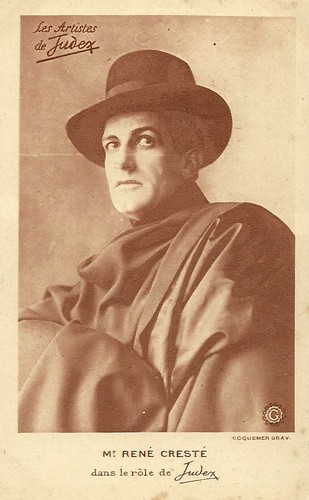
French postcard by Coquemer Gravures. Photo: Gaumont. Still for La nouvelle mission de Judex (1917-1918).
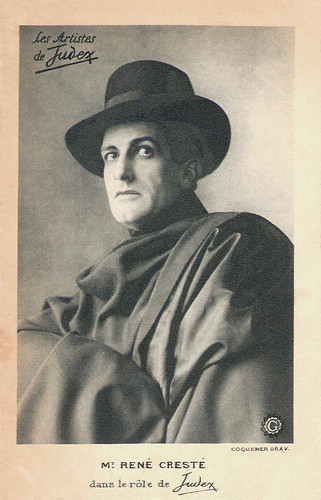
French postcard by Coquemer Gravures. Photo: Gaumont. Still for La nouvelle mission de Judex (1917-1918).
Eyes Without a Face
Following the success of Judex, René Cresté appeared in the serials Tih Minh (Louis Feuillade, 1918), and Vendémiaire (Louis Feuillade, 1918) with Édouard Mathé and Mary Harald. Both were less successful than Judex.
He also appeared in the films L’homme sans visage/Eyes Without a Face (Louis Feuillade, 1919) with Gina Manès, L’engrenage/The gearing (Louis Feuillade, 1919) with Geneviève Félix, and L’énigme/Enigma (Louis Feuillade, 1919) with Fernand Herrmann.
Then Cresté founded his own film production company, Films-René-Cresté, for which he produced and directed Le château du silence/The Silent Castle (René Cresté, 1919) and L’aventure de René/René’s Adventure (René Cresté, 1921).
His last film was Un coup de tête/A Whim (René Cresté, 1922). All his productions were ultimately unsuccessful. Disappointed and ruined he decided to take the management of a Parisian Cinema, the Cocorico. He also played Judex again at the stage of the Gaîté-Rochechouart.
In 1922, René Cresté died of tuberculosis in Paris, aged 40. To support the financial needs of his widow and infirmed daughter, a charity gala was organised by friends of the Cresté family with the help of the Surrealist artists in February 1929. Three months following the event, his only daughter Renée died. She was buried next to her father.

French postcard by Coquemer Gravures. Photo: Production Gaumont. Still for the sequel La nouvelle mission de Judex (1917-1918) with Georgette de Néry.
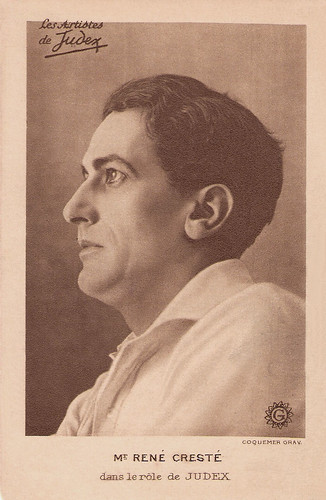
French postcard by Coquemer Gravures. Photo: Production Gaumont. René Cresté in the role of Judex in La nouvelle mission de Judex (1917-1918).

British postcard. René Cresté and Mary Harald in Tih-Minh (Louis Feuillade, 1919).
Sources: Jeffrey M. Anderson (Combustible Celluloid), Philippe Pelletier (CinéArtistes - French), French Wold Newton Universe, Wikipedia and IMDb.
This post was last updated on 7 November 2023.

No comments:
Post a Comment